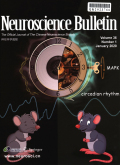- 钛学术文献服务平台 \
- 学术期刊 \
- 医药卫生期刊 \
- 神经病学与精神病学期刊 \
- 神经科学通报(英文版)期刊 \
null
Combining Human and Rodent Genetics to Identify New Analgesics
基本信息来源于合作网站,原文需代理用户跳转至来源网站获取
摘要:
Most attempts at rational development of new analgesics have failed,in part because chronic pain involves multiple processes that remain poorly understood.To improve translational success,one strategy is to select novel targets for which there is proof of clinical relevance,either genetically through heritable traits,or pharmacologically.Such an approach by definition yields targets with high clinical validity.The biology of these targets can be elucidated in animal models before returning to the patients with a refined therapeutic.For optimal treatment,having biomarkers of drug action available is also a plus.Here we describe a case study in rational drug design:the use of controlled inhibition of peripheral tetrahydrobiopterin (BH4) synthesis to reduce abnormal chronic pain states without altering nociceptive-protective pain.Initially identified in a population of patients with low back pain,the association between BH4 production and chronic pain has been confirmed in more than 12 independent cohorts,through a common haplotype (present in 25% of Caucasians) of the rate-limiting enzyme for BH4 synthesis,GTP cyclohydrolase 1 (GCH1).Genetic tools in mice have demonstrated that both injured sensory neurons and activated macrophages engage increased BH4 synthesis to cause chronic pain.GCH1 is an obligate enzyme for de novo BH4 production.Therefore,inhibiting GCH1 activity eliminates all BH4 production,affecting the synthesis of multiple neurotransmitters and signaling molecules and interfering with physiological function.In contrast,targeting the last enzyme of the BH4 synthesis pathway,sepiapterin reductase (SPR),allows reduction of pathological BH4 production without completely blocking physiological BH4 synthesis.Systemic SPR inhibition in mice has not revealed any safety concerns to date,and available genetic and pharmacologic data suggest similar responses in humans.Finally,because it is present in vivo only when SPR is inhibited,sepiapterin serves as a reliable biomarker of target engagement,allowing potential quantification of drug efficacy.The emerging development of therapeutics that target BH4 synthesis to treat chronic pain illustrates the power of combining human and mouse genetics:human genetic studies for clinical selection of relevant targets,coupled with causality studies in mice,allowing the rational engineering of new analgesics.

推荐文章
期刊_丙丁烷TDLAS测量系统的吸收峰自动检测
带间级联激光器
调谐半导体激光吸收光谱
雾剂检漏 中红外吸收峰 洛伦兹光谱线型
不同盐度、温度及光照对漂浮浒苔生理生态的影响
浒苔
盐度
温度
光照
生理生态
期刊_联合空间信息的改进低秩稀疏矩阵分解的高光谱异常目标检测
高光谱图像
异常目标检测 低秩稀疏矩阵分解 稀疏矩阵 残差矩阵
内容分析
关键词云
关键词热度
相关文献总数
(/次)
(/年)
文献信息
| 篇名 | Combining Human and Rodent Genetics to Identify New Analgesics | ||
| 来源期刊 | 神经科学通报(英文版) | 学科 | |
| 关键词 | |||
| 年,卷(期) | 2018,(1) | 所属期刊栏目 | |
| 研究方向 | 页码范围 | 143-155 | |
| 页数 | 13页 | 分类号 | |
| 字数 | 语种 | 英文 | |
| DOI | |||
五维指标
引文网络
引文网络
二级参考文献 (0)
共引文献 (0)
参考文献 (131)
节点文献
引证文献 (0)
同被引文献 (0)
二级引证文献 (0)
1958(2)
- 参考文献(2)
- 二级参考文献(0)
1959(1)
- 参考文献(1)
- 二级参考文献(0)
1961(1)
- 参考文献(1)
- 二级参考文献(0)
1962(1)
- 参考文献(1)
- 二级参考文献(0)
1964(1)
- 参考文献(1)
- 二级参考文献(0)
1972(1)
- 参考文献(1)
- 二级参考文献(0)
1974(1)
- 参考文献(1)
- 二级参考文献(0)
1976(1)
- 参考文献(1)
- 二级参考文献(0)
1983(1)
- 参考文献(1)
- 二级参考文献(0)
1986(1)
- 参考文献(1)
- 二级参考文献(0)
1988(2)
- 参考文献(2)
- 二级参考文献(0)
1989(1)
- 参考文献(1)
- 二级参考文献(0)
1996(1)
- 参考文献(1)
- 二级参考文献(0)
2000(3)
- 参考文献(3)
- 二级参考文献(0)
2001(4)
- 参考文献(4)
- 二级参考文献(0)
2002(4)
- 参考文献(4)
- 二级参考文献(0)
2003(4)
- 参考文献(4)
- 二级参考文献(0)
2004(4)
- 参考文献(4)
- 二级参考文献(0)
2005(5)
- 参考文献(5)
- 二级参考文献(0)
2006(4)
- 参考文献(4)
- 二级参考文献(0)
2007(1)
- 参考文献(1)
- 二级参考文献(0)
2008(3)
- 参考文献(3)
- 二级参考文献(0)
2009(11)
- 参考文献(11)
- 二级参考文献(0)
2010(5)
- 参考文献(5)
- 二级参考文献(0)
2011(7)
- 参考文献(7)
- 二级参考文献(0)
2012(10)
- 参考文献(10)
- 二级参考文献(0)
2013(5)
- 参考文献(5)
- 二级参考文献(0)
2014(16)
- 参考文献(16)
- 二级参考文献(0)
2015(15)
- 参考文献(15)
- 二级参考文献(0)
2016(8)
- 参考文献(8)
- 二级参考文献(0)
2017(7)
- 参考文献(7)
- 二级参考文献(0)
2018(0)
- 参考文献(0)
- 二级参考文献(0)
- 引证文献(0)
- 二级引证文献(0)
引文网络交叉学科
相关学者/机构
期刊影响力
神经科学通报(英文版)
主办单位:
中国科学院上海生命科学研究院
出版周期:
双月刊
ISSN:
1673-7067
CN:
31-1975/R
开本:
16开
出版地:
上海市岳阳路319号31B楼405室
邮发代号:
4-608
创刊时间:
1985
语种:
eng
出版文献量(篇)
2003
总下载数(次)
1
总被引数(次)
9688
期刊文献
相关文献
推荐文献
- 期刊分类
- 期刊(年)
- 期刊(期)
- 期刊推荐
神经科学通报(英文版)2022
神经科学通报(英文版)2021
神经科学通报(英文版)2020
神经科学通报(英文版)2019
神经科学通报(英文版)2018
神经科学通报(英文版)2017
神经科学通报(英文版)2016
神经科学通报(英文版)2015
神经科学通报(英文版)2014
神经科学通报(英文版)2013
神经科学通报(英文版)2012
神经科学通报(英文版)2011
神经科学通报(英文版)2010
神经科学通报(英文版)2009
神经科学通报(英文版)2008
神经科学通报(英文版)2007
神经科学通报(英文版)2006
神经科学通报(英文版)2005
神经科学通报(英文版)2004
神经科学通报(英文版)2003
神经科学通报(英文版)2002
神经科学通报(英文版)2001
神经科学通报(英文版)2000
神经科学通报(英文版)2018年第6期
神经科学通报(英文版)2018年第5期
神经科学通报(英文版)2018年第4期
神经科学通报(英文版)2018年第3期
神经科学通报(英文版)2018年第2期
神经科学通报(英文版)2018年第1期

 免费查重
免费查重










